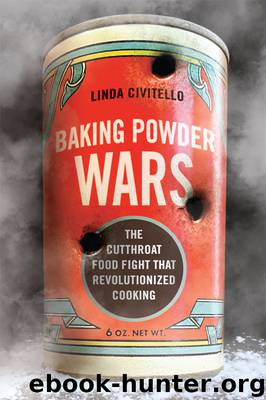Baking Powder Wars by Linda Civitello

Author:Linda Civitello
Language: eng
Format: epub
Publisher: University of Illinois Press
Published: 2017-04-08T04:00:00+00:00
The Biscuit Crusade
In the first decades of the twentieth century, baking powder, along with wheat flour, inadvertently received a boost from medicine and women in the new field of home economics. A rise in the disease pellagra was thought to be caused by musty or moldy corn. The medical profession was divided on the cause of pellagra. Some physicians thought it was infectious, transmitted person-to-person. Other scientists, following in the footsteps of Pasteur and Koch, sought a solution in bacteriology and tried to isolate the organism in the corn that they believed was the cause.35
Neither hypothesis was correct. Pellagra was not a communicable disease, and it was not caused by what was in the corn, but what was absent from it. Pellagra was first identified by Italian physicians in the nineteenth century when Italians began widespread consumption of American maize as a staple food called polenta. “Pellagra” is an Italian word that means “rough skin,” one of the symptoms of the disease. Without nixtamalization, the addition of vegetable ash, which the Aztecs had used to process corn, it was deficient in the necessary B vitamin niacin. Europeans had taken the grain native to the Americas but not the nourishing technique the Native Americans used to process it.
As the theory that corn was the culprit gained ground, especially in some areas of the American South, the solution was clear: replace corn with wheat, cornbread with wheat bread and biscuits. The home economists’ missionary zeal led them to Appalachia, where they tried to replace the traditional corn bread with wheat biscuits. These Northern home economists regarded the residents of Appalachia the same way that Christian missionaries looked at Native Americans: as uncivilized. Like the religious missionaries on the reservations, home economists, too, regarded the ultimate sign of civilization as bread and biscuits made from wheat.36
However, the flour that replaced corn was not nutritious dark whole wheat, but refined and white, run at high speed through steel rollers. Lower in gluten than bread flour, it did not bake up elastic and chewy, even in yeast breads. It made a soft crumb that was better for foods made with baking powder: biscuits, cakes, pancakes, waffles, and quick breads. Most importantly, it baked up white.
Download
This site does not store any files on its server. We only index and link to content provided by other sites. Please contact the content providers to delete copyright contents if any and email us, we'll remove relevant links or contents immediately.
Life 3.0: Being Human in the Age of Artificial Intelligence by Tegmark Max(5189)
The Sports Rules Book by Human Kinetics(4079)
The Age of Surveillance Capitalism by Shoshana Zuboff(3990)
ACT Math For Dummies by Zegarelli Mark(3853)
Blood, Sweat, and Pixels by Jason Schreier(3494)
Unlabel: Selling You Without Selling Out by Marc Ecko(3472)
Hidden Persuasion: 33 psychological influence techniques in advertising by Marc Andrews & Matthijs van Leeuwen & Rick van Baaren(3292)
Urban Outlaw by Magnus Walker(3243)
The Pixar Touch by David A. Price(3210)
Bad Pharma by Ben Goldacre(3098)
Project Animal Farm: An Accidental Journey into the Secret World of Farming and the Truth About Our Food by Sonia Faruqi(3018)
Brotopia by Emily Chang(2898)
Kitchen confidential by Anthony Bourdain(2831)
Slugfest by Reed Tucker(2803)
The Content Trap by Bharat Anand(2778)
The Airbnb Story by Leigh Gallagher(2702)
Coffee for One by KJ Fallon(2422)
Smuggler's Cove: Exotic Cocktails, Rum, and the Cult of Tiki by Martin Cate & Rebecca Cate(2339)
Beer is proof God loves us by Charles W. Bamforth(2251)
